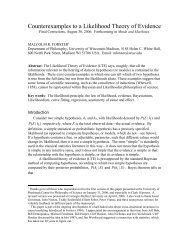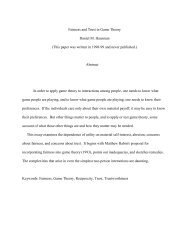1 What does a confidence interval mean? Elliott Sober Suppose you ...
1 What does a confidence interval mean? Elliott Sober Suppose you ...
1 What does a confidence interval mean? Elliott Sober Suppose you ...
You also want an ePaper? Increase the reach of your titles
YUMPU automatically turns print PDFs into web optimized ePapers that Google loves.
The difference between the true principle (T) and the false principle (F) is the same as the<br />
difference between Pr(X│Y) and Pr(X&Y). The sentence quoted at the start of this<br />
paragraph is false or misleading as stated. Notice that the figure could not be<br />
drawn without first deciding what the true value of Θ, the population <strong>mean</strong>, is.<br />
The probability of 0.95 in (T) indicates that <strong>you</strong> should expect that about 95% of<br />
the CI’s constructed from different data sets will include the population <strong>mean</strong> and about<br />
5% will fail to do so. The figure shows the CI’s drawn for 40 data sets. There are 4<br />
failures here, which is a few more than the expected value (2), but of course that sort of<br />
thing can happen.<br />
One further comment: (T) talks about the probability that “a” 95% CI will<br />
contain the number x. Why the indefinite article? Two points are relevant. First, there<br />
are many 95% CI’s that might be constructed from a single data set. Second, the claim is<br />
not that at least one of those 95% CI’s will have a probability of 0.95 of containing the<br />
number x. Rather, (T) should be understood to assert that each of those 95% CI’s has a<br />
probability of 0.95 of containing the number x. To simplify our discussion, I’m going to<br />
assume that there is just one 95% CI that an investigator will construct from a given data<br />
set. This involves rewriting (T), slightly, as follows:<br />
(T*) For any x, Pr(the 95% CI constructed from data drawn from the population will<br />
contain x│Θ = x) = 0.95.<br />
* * *<br />
The true principle (T*) is a universal generalization, and the principle from<br />
deductive logic called universal instantiation (from “all x’s are F,” infer that the<br />
individual i is F) applies to it. That is, it follows from (T*) that<br />
And that<br />
Pr(the 95% CI constructed from data drawn from the population will contain<br />
14│Θ = 14) = 0.95.<br />
Pr(the 95% CI constructed from data drawn from the population will contain<br />
6│Θ = 6) = 0.95.<br />
Now suppose <strong>you</strong>r data lead <strong>you</strong> to construct the 95% CI whose bounds are [5,7]. Does<br />
it follow from the above two displayed statements that<br />
and that<br />
Pr([5,7] contains 14│Θ = 14) = 0.95.<br />
Pr([5,7] contains 6│Θ = 6) = 0.95?<br />
2




